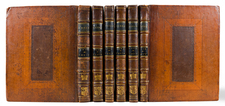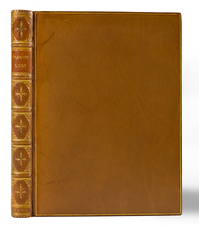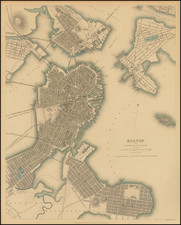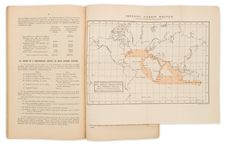"Don't give up the ship!"
Contemporary Manuscript List of the Killed and Wounded on the U.S.S. Chesapeake, as Recorded by the Ship's Purser
One of the Most Famous Naval Battles of the Fledgling U.S. Navy
A truly remarkable manuscript from one of the most famous battles in the history of the U.S. Navy, the original manuscript record of the names and ranks of the killed and wounded on the USS Chesapeake during her defeat by the British frigate HMS Shannon. This list was compiled by the Chesapeake's purser, Thomas Chew, in the immediate aftermath of the battle. In fact, the ship's captain, James Lawrence, is still noted as "wounded." A manuscript emendation in red ink ('D.D.") indicates what we already know from history: he died a short time later from his wounds.
In fact, the date of the creation of the document can be definitively established by the inclusion of at least two names as "Wounded" but then marked "deceased". The most important of these is Peter Adams, a boatswain, who is listed as wounded but died on the day of the battle, June 1, and has subsequently been marked "D.D." The second significant amendment is the aforementioned for Captain Lawrence, who died on June 4. With these details, it is evident that Chew created the list on the day of the battle and continued updating it as the wounded died.
The USS Chesapeake
During the War of 1812, the Chesapeake fought a brief but intense battle in Boston Harbor on June 1, 1813, resulting in her capture by the HMS Shannon. This was one of the most famous battles of the nascent American Navy and resulted in the loss of dozens of American sailors. It was during this battle that the Chesapeake's captain, James Lawrence, uttered the now immortal order to his crew: Don't give up the ship! before succumbing to his wounds.
The Chesapeake was a 38-gun wooden-hulled, three-masted frigate, one of six such vessels commissioned by the Naval Act of 1794, and the only one not named by George Washington. She performed well in the Quasi-War with France and middlingly in the First Barbary War, but by 1807 her fortunes began to turn. Encountering the HMS Leopard just off the coast of Virginia, Captain Barron of the Chesapeake refused to allow the British to search his ship for deserters from the Royal Navy. The Leopard responded with force, and the unprepared Chesapeake surrendered without a fight. Several American soldiers died in the engagement, and public outrage against Britain was swift and fervent. While President Jefferson avoided a war in the short term, the Chesapeake-Leopard Incident led directly to the Embargo Act of 1807 and, through it, the War of 1812.
Earlier in the War of 1812, the Chesapeake found some success by capturing six British trading ships around South America and the West Indies. Returning to Boston in April 1813, her command was taken by Captain James Lawrence amidst considerable crew turnover. The HMS Shannon was approaching Boston at the time, and the two ships engaged in battle on June 1st. Early on in the conflict, the Chesapeake inflicted notable damage to the Shannon, but the better-trained and more experienced British gunners dealt out far more destruction than they received. The battle was given immortality thanks in part to the final order of the Chesapeake's captain, James Lawrence, who commanded his crew: Don't give up the ship! before he himself died from wounds sustained in the battle. Captain Philip Broke of the Shannon mounted a swift boarding action and, although he was wounded in the assault, quickly overwhelmed the panicked and already badly wounded American crew. The Chesapeake was taken in by the British Royal Navy and operated around Halifax as the "HMS Chesapeake" for the remainder of the war. She remained in British hands, with her flag on display in London, until she was broken down and sold for scrap in 1819. Some of the timbers of the Chesapeake were repurposed as a flour mill built in Wickham, England in 1820 and that structure remains intact to this day.
The Butcher's Bill
This record of the American vessel's killed and wounded clearly reflects the disastrous nature of the engagement. The document lists the names and ranks of forty-eight killed and ninety-eight wounded at the time it was first written, including numerous officers and the ship's chaplain Samuel Simmons. The situation grew even worse as the captured vessel made its way to the British base at Halifax, and notes in red or black ink on this list reveal that fourteen of the wounded had by then succumbed to their injuries, including Captain Lawrence. The names and ranks of the seamen who were killed are given first, followed by a list of the names of the twelve marines who lost their lives in the battle. The names and ranks of those wounded take up the other four columns, with manuscript notes reading "DD" in red or black ink, denoting that they perished from their injuries.
It is interesting to compare the information on the present document with the exaggerated American death tally contained in the official account of the battle sent out by Halifax station chief Thomas Bladen Capel (who was permitted to sign it under the name of the ailing Captain Philip B.V. Broke of the Shannon). The latter document, dated June 6, 1813, is highly laudatory of the British sailors, describing them as "gallant bands ... driving every thing before them with irresistible fury." The Americans are described as putting up a "desperate, but Disorderly resistance," finally resulting in a "loss of the Enemy [of] about Seventy killed, and One hundred Wounded." Indeed, the bloody hand-to-hand combat actually resulted in a total of 228 men killed or wounded from both sides and was the bloodiest frigate action of the war. Nevertheless, the success of the Shannon was a boon to the British Navy and British morale at a critical moment in the war.
Thomas J. Chew
The document offered here, though not signed, is written in the hand of Thomas J. Chew, purser aboard the Chesapeake and formerly a member of the crew of the USS Constitution. Chew was a native of New London who began his naval career at the outbreak of the Quasi-War. He joined the Constitution's crew in June 1812 and received a Congressional Silver Medal for his role in that ship's victory over the Guerriere, and shortly afterward was transferred to the Chesapeake. Chew was known for his rather expensive tastes in fashion and luxury items, and his corset (stays) and other personal items are now held at the USS Constitution Museum in Charlestown, Massachusetts.
An important and wonderfully immediate document of American history, recording the aftermath of an early and famous defeat of the U.S. Navy in the War of 1812, before the final death tally was known.
The famous naval duel between the USS Chesapeake and the HMS Shannon inspired one of the U.S. Navy's most enduring mottos, so brilliantly fixed in the public's imagination by Commandant Oliver Hazard Perry's "Don't give up the ship" battleflag flown on the U.S. Brig Lawrence during his decisive victory in the Battle of Lake Erie later in the same year.
Provenance
Dietrich American Foundation, acquired in the 1960s.












![(Southeast Asia) [Unpublished Manuscript Sailing Directions from Europe to China by a French Navigational Officer]](https://storage.googleapis.com/raremaps/img/small/90507.jpg)
![De La Democracia en la América del Norte, Lecointe, Paris 1837 [with map:] Mapa para la obra intitulada Democracia en America](https://storage.googleapis.com/raremaps/img/small/101984.jpg)


